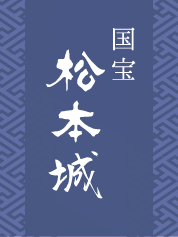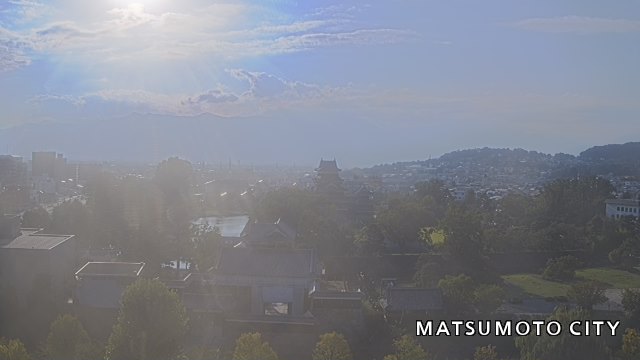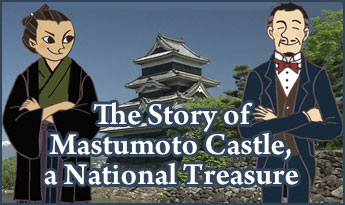West trail
From Ninomaru to the west moat, you can enjoy a walk from the town of town people to Matsumoto Shrine which is located in the North of the castle.
The walk of the west moat which mounds of earth from digging the most outer part of the main moat can be seen, Rokku where samurai walked, and Takajo-machi where falconers lived.
Route map
There are many segments to the west trail

Ninomaru
There were palaces and warehouses in Edo era.
Where the castle tower was, there were the main enclosure of the castle and an inner moat. Outside of them, there were outer citadel and an outer moat. And again, there were outer most area of the castle and main moat and another defensive moat. Inside of the main moat was an area of Matsumoto castle.
In the castle tower, there were a castle tower and a palace. The main enclosure of the castle is now a park but in Edo era, there were many buildings including a Ninomaru palace and Kosanji Palace, a warehouse for equipments, a warehouse for rice and a warehouse for gun powder. In the east, there was a traditional house for tea ceremony and garden where Lords could relax.
The main enclosure of the castle was surrounded by fence. Some parts of the outer moat still remain to the east but others are hidden by newly built houses. The city is now planning to return the moat to its previous state. The entrance to the main enclosure of the castle was Taikomon (Taiko Gate).- Continue to walk about 2 minutes

Udekimon(Udeki Gate), owned by Family of Arai
The view of the castle environs where samurai lived
The house of Arai was within the outer most area of the castle. In the outer most area of the castle, higher status samurai houses could be found.
Many houses could be found within the fenced area and was accessed through the gate. This was the typical samurai scene who lived in the castle environs.
Because of the fire and the reconstruction of the houses, original samurai houses are not found in the outer most area of the castle anymore. However the gate to the house of Arai still remains to this day. This gate is 2.95 meters wide. Although the gate itself is 2.4 meters high but passage way for people to walk through is only 1.4 meters. The roof is supported by a tall pole which is connected by a strong cantilever support which can be said to be a man with his arms out stretched. This is why it is called "Udegimon" (Arm tree gate). Parts of the gate can still be seen to be the original red.- Continue to walk about 1 minute

West main moat mount, Rokku
The mount which surrounded the outer most area of the castle
The earth which was left from building the furthest main moat from the castle was put inside the moat and the embankment was constructed. This was called "mount of earth". The outer most area of the castle was surrounded by mounds of Earth during the Edo era.
During the Meiji era, these mounds of earth were compacted and they were used to fill the moat and now very little remains. The examples of these remaining mounds of earth can be found at Nishibori and Kitababa Metropolitan Oyanagi cho (Oyanagi Town) (total moat of earthworks) and one end-cho (details on how town) and Higashi (earthworks of shahori), and only tiny traces can been seen.
The mounds of earth of the main moat in the west were accidentally discovered and following a period of excavation they were repaired to a good condition. The base of the mounds of earth were 17 meters, 3.5 meters high and further 2.5 meters on top of that.
In the west of the mounds of earth was a moat and in the east of the mounds of the earth are houses of the samurai. From this panel you can learn the process of the excavation and the explanations of the mounds of earth.Outside the Ote gate, the west street is called Rokku. The name of the Rokku (69 in Japanese) is from the number of horse rooms which Naomasa Matsudaira made. (6 x 9 = 54). When the period of Mr. Toda began an office of the domain was built and it was used as a political place for a town and a city. The name of Rokku (69 in Japanese) is from the number of horse rooms which Maomasa Matsudaira made. (6 x 9 = 54)
- Continue to walk about 5 minutes

Zenkyuin and Jourinji
This temple was moved to Matsumoto by a Lord.
The temple Zenkyuin is now located in Miyamuracho in Matsumoto but in the Edo era it was located here between metobagawa and isebashi and all the ancestors of Mr. Toda were buried.
Many years ago, the temples that were well connected to the Lord moved with him. Zenkyuin moved to Matsumoto with Mr. Toda. There was a temple called Shunryoji which was well connected to Mr. Mizuno, and Zenkyuin was relocated to this site.
During the Meiji era the domain of Matsumoto attempted to demise all temples. Zenkyuin lost its function as a temple because of this attempt and only the building remained. This building was used to open a school. The school was called "Kaichi school". In 1877, the building was reconstructed. This is "Kaichi school" now which is selected as an important cultural property. This school building used to be located here.
Jourinji is a temple located in the west of Zenkyuin and it was moved during the period of Sadayoshi Ogasawara. It is said that it has been here from the beginning of the Matsumoto castle environs and Yasunaga Ishikawa worshipped a mortuary tablet here. This temple was center of Joudoshu (Joudo Sect). The main gate of this Buddhist temple consists of these structures. Four supporting pillars and a gabled roof are built between 1688 and 1704. A bell tower was built in 1845 by Washirotomimasa Tatekawa who was a carpenter in Suwa. And the scripture of a dragon was made by Kousaburo Harada from Matsumoto.- Continue to walk about 1 minute

Isemachi hall of a guardian deity of children
The hall of a guardian deity of children is now located behind a public hall in Fundocho. Isemachi was the west entrance to the castle environs, therefore there must have been a hall of Juo. It is written that a hall of a guardian deity of children was built in 1692 on the picture of the Genroku era. It looks like it was replaced to a hall of a guardian deity of children during the early Edo era. The location is the west of Isemachi and it is east side of where a hall is now.
On the guardian deity of children, the year of 1702 is engraved.- Continue to walk about 2 minutes

Watari Shrine
There is a theory that people prayed for the security of river.
The name Watari Shrine is rare and there are not many of them in Japan.
It is said that this shrine was worshipped in Shiraita Village in 1706 and it was relocated to this location in 1857. It is said that the family of Orii worshipped at the beginning but now it is worshipped as a local deity of the destruct one in Imamachi.
It is located by a river and the name "Watari" also means "cross", therefore people perhaps prayed so they can avoid suffering from overflow of the Metoba River and for security of crossings over the river.- Continue to walk about 1 minute

Imamachi
A new town which was built outside the castle environs.
It is located outside the castle environs. There was no development in the west of the west moat of the Matsumoto castle environs.
It is said that people from Shiraita Village located in the west moved and therefore the town was built in 1728. "ima" means "new".
It is now an important road leading to Matsumoto station. During the Edo era, this road was used to go to Arigasaki and 333 without going through the castle.
In the left picture, the access from Isemachi to Imamachi via crossing Metoba River is shown. There is no bridge over Metoba River in this picture.- Continue to walk about 13 minutes

Takajoumachi and Kita-baba
Baba and a town where falconer lived.
Takajoumachi was established in the Northwest of Matsumoto castle outside the main moat at the period of Mr. Mizuno.
Many years ago, hawks were used to hunt and it was called a falconry. Falconry was popular among the lords. There were people who breeds and trains hawks within a domain so they move well when a Lord played falconry. These people were called falconer. Because falconers lived here, the town was named Takajoumachi (falconer town).
The road which leads along the North main moat in the east of Takajoumachi is called Kita-Baba. The length of the road is 289 meters and this was a riding ground and used to practice horseback riding. There is a parking lot for city employees in the east of Kita-baba Street. The mounds of earth of the main moat can be seen on the slope in the south of a parking.- Continue to walk about 1 minute

Nishi-Akazunomon and Kita-Akazunomon
These gates were closed most of the time.
There were only five entrances to outer most area of the castle in Matsumoto Castle. The Ote Gate was used as a main entrance, the East Gate was for the everyday use, the North Gate was for samurals who lived in the North to enter Sannomaru, and there were Nishi-akazuno-mon and Kita-akazuno-mon. Akazuno-mon (lit. Not-to-open-gate) was usually closed.
Nishi-Akazunomon was located at north side of Matsumoto Tax Office. Kita-Akazunomon was in the northwest of Matsumoto Shrine. A record of the natural fire from the raincoats with paulownia oil coating during Mr. Mizuno period was found about Kita-Akazunomon therefore it is believed that this was used as a stock room. There was a workshop near Nishi-Akazunomon. There is a record about farmers going through this gate to clean and changed water of the moats during Mr. Toda period.- Continue to walk about 1 minute

Matsumoto Shrine
The shrine which worships five God and Wakamiya Hachimangu.
Matsumoto Shrine and Matsumoto castle have deep relationship. When Mr. Toda came to Matsumoto, he built a shrine and temple. During the period of Mr. Mizuno there was a house of samurai.
The first boss of the domain Yasunaga's child Nagakane was buried here at Youkoku Reisha. There became 5 spirits after worshipped Mr. Toda's ancestor therefore it is now called Gosha. Where the court is he built a temple called Miroku-in to protect the shrine.
Because this shrine was built by Mr. Toda it was not for people like these days. In the outer moat in the south of Akechi parking, there is a mount ground like an island. There was a shrine which had a relationship with a castle called Wakamiya Hachiman. In 1914, Wakamiya Hachiman was relocated to the ground of Gosha shrine. On the left hand side of the main shrine there is Wakamiya Hachiman. On the left hand side, there is a Gosha shrine. Later in 1953 two buildings were combined together and the name was changed to Matsumoto Shrine. neighbors worship the shrine as a local deity.


















